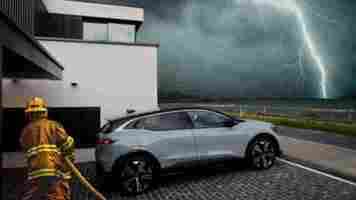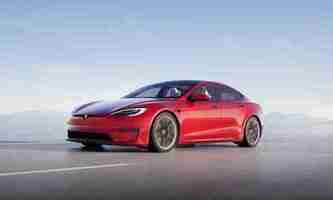Renault’s Megane E-Tech has cool new features for quenching battery fires
Did you know SHIFT is taking the stage this fall ? Together with an amazing line-up of experts, we will explore the future of mobility during TNW Conference 2021. Secure your ticket now!

At the 2021 IAA Mobility Show on Monday, Renault premiered its electric Megane E-Tech . While the car is loaded with interesting characteristics, its safety features are by far the most impressive.


It seems like Renault has truly doubled down on a “safety first” approach by equipping its latest EV with the so-called Fireman Access feature.
The Fireman Access is the innovative child of the 10-year collaboration between Renault and French firefighters, as part of the brand’s aim to facilitate their work when responding to accidents.
The EV includes special access for rescue teams which they can use when quenching a battery fire. Renault claims that this way firefighters can extinguish flames in just five minutes, as opposed to one to the three hours it usually takes.
There’s also a special switch under the rear bench which enables rescue teams to disconnect the battery from the high voltage circuit of the vehicle.
The second innovation is a QR code affixed to Megane E-Tech’s windshield. It’s intended to be scanned by emergency services, providing them with all the technical specs they need for the rescue operation.
This necessary data takes the form of a rescue sheet which provides first responders with the car’s structural information, including the location of the battery and airbags and ideal spots for quick and risk-free cutting.
There’s no doubt that this information is vital when it comes to extracting someone from a crashed vehicle. And as a matter of fact, Renault claims that it can save up some precious 15 minutes in response time.
The Fireman Access and the QR code are part of Renault’s “Safety Coach” measures and will appear on all Renault Group vehicles in Europe as of 2022. When this is realized, firefighters will also be able to determine if the vehicle is an EV, HEV, or PHEV model.
The Megane E-Tech is equipped with a number of other notable safety features as well, such as Rear Automatic Emergency Braking and Occupant Safe Exit, but the Fireman Access is clearly the most eye-catching.
Not only is this innovation in car safety a smart move for Renault to distinguish itself as a brand, but also — more importantly — an amazing addition that could save lives.
I really hope though that Renault’s distinction won’t last for long and other automakers adopt similarly smart safety features.
Do EVs excite your electrons? Do ebikes get your wheels spinning? Do self-driving cars get you all charged up?
Then you need the weekly SHIFT newsletter in your life. Click here to sign up.
Tesla vs. robotaxis: Who’s winning the autonomous vehicle race?
We’re on the edge of a major social shift in mobility. Autonomous vehicles are going to change our lives. Commutes will be unrecognizable, cities will change, and industries reshaped.

We’re still a long way away from that — but companies are edging ever closer.
There are prime examples, both approaching the challenge in very different ways. The first is Tesla, with its beta-testing of Level 2 driver-assist tech that aims to progress to full vehicle automation.
The second is a group of companies involved in the development and deployment of autonomous robotaxis.
But how do they compare? And how do we get from here to a fully autonomous future?
If we look beyond the tech alone, two significant measures of success come to mind: partnerships and capacity for scale.
By partnerships, I mean industry collaborations that advance not only the number of vehicles, but the tech, as well as its accessibility to users.
Scale is also critical. We need a lot of cars on the road before vehicle automation is anywhere near hitting critical mass.
Let’s a look at how the two approaches face up against each other.
How do Tesla sales compare to the number of robotaxis on the road?


In 2021, Tesla reportedly produced and delivered over 930,000 electric cars worldwide.
If we look at the number of sales alone, that’s a mammoth army of Tesla owners.
And, spoiler: there is nowhere near that number of autonomous robotaxis on the roads – in testing or otherwise. So, if Tesla can successfully develop autonomous tech, they win the battle on private car ownership alone.
That’s a big “if” though, especially considering they’re only testing Level 2 vehicle automation.
So, could Tesla even get from cars to robotaxis?
Currently, Tesla ’s driver-assist cannot be deployed without an initial safety score determined by monitoring user behavior over some time.
If the company’s goal is to go from driver-assist FSD to robotaxi, a lot needs to go right. Plus, there has to be a technological improvement — much of which current robotaxi makers are already deploying.
The reality is that no one knows how easy it will be to switch Tesla FSD beta testers into Level 3 and 4 autonomation , let alone full automation.
Last year Musk announced that the number of American FSD Beta vehicles went from a couple of thousand in Q3, to nearly 60,000 by the end of Q4 — a massive leap in anyone’s book.
By comparison, if we look at China, the adoption of FSD is surprisingly low. It sits at 1% to 2%, compared to an adoption of 20% to 25% in the US and Europe.
Tesla’s business model is deploying owners to test their software as it evolves, so they can iron out the bugs.
But these low adoption rates suggest there are a lot of people who don’t want to drive their car with driver-assist, let alone full automation. This makes it difficult to advance their driving tech in the real world. Especially when we compare it to the heavy lifting already done by companies like Argo, Cruise, and Waymo .
But Tesla’s gaining partners
Prior to the challenges of getting enough beta testers, Elon Musk predicted that Tesla will have their own robotaxis on the road by 2023. Can it succeed?
In 2021, the company sold over 100,000 Model 3 cars to Hertz. And in October of the same year, Hertz and Uber also announced a partnership to make up to 50,000 Teslas available by 2023 for Uber drivers to rent.
But does this translate to 100,000 robotaxis in the making? Hardly! They’re still beta testing Level 2!
C ompare this to the groundwork existing robotaxi companies have put in.
Autonomous Robotaxi are deeply partners with the titans of industry
Robotaxi companies Baidu Apollo, AutoX, Pony.ai, WeRide, Didi, WeRide, Waymo, Argo, Aurora, and Cruise, are all partnering with various brands to develop the technology needed to get autonomous taxis on the road.
Cruise (majority-owned by GM) is currently deploying autonomous robotaxis in San Francisco. In 2021, Cruise CEO Dan Ammann announced a target for at least one million self-driving vehicles by 2030. This feels like a far more realistic and achievable aim than what Tesla has suggested.
There’s also the challenge of geographic expansion
It’s not all plain sailing. Let’s not forget how the legal status of autonomous vehicle technology differs wildly throughout different parts of the US. How easy will it be to get all states on board?
Currently, autonomous taxis only operate on pre-mapped streets. By comparison, Tesla FSD drivers can go anywhere.
We have no way to know if autonomous robotaxis will have mapped the whole of the US before Teslas are operating without human drivers.
Who’s in the best position?
If I was to place a bet, I think we’ll see more Teslas on the road than robotaxis.
But here’s the kicker: the Teslas won’t be autonomous. Maybe they’ll progress from Level 2, but I can’t see them going from Level 2 to 5 without a lot of challenges — especially in safety and regulatory approval.
So there we are. The robotaxi industry and Tesla have significant challenges scaling and evolving their tech. Furthermore, they all need to convince the public that they want to travel by autonomous vehicle — and this may be their biggest challenge of all.
Will your autonomous car abandon you if you miss payments?
This article was originally published by Martin Banks on Clean Fleet Report , a publication that gives its readers the information they need to move to cars and trucks with best fuel economy, including electric cars, fuel cells, plug-in hybrids, hybrids and advanced diesel and gasoline engines.

New technology raises new legal questions
More than 1,400 autonomous vehicles from more than 80 companies are being tested on US roads. As they continue to make headlines, their presence raises a few questions about how they might change society.
These hypotheticals range from serious to ridiculous–somewhere in the middle lies this question: If you were leasing a self-driving car and fell behind on payments, could it repossess itself? The repo process would certainly be easier if lenders could simply summon vehicles.
This isn’t the kind of thing that happens today, of course, but that could change. Electric trucks once seemed unlikely, and now multiple manufacturers offer electric pickups , from Ford to Tesla . As self-driving car technology advances and society adapts, autonomous repossession could be possible.
Technological barriers
One of the most significant barriers to automatic repo is self-driving cars’ biggest obstacle as a whole: technology. Today’s autonomous vehicles can’t drive themselves , and it could take years before that’s a possibility. Traffic has too many variables, and if a self-driving car crashes on its way back to the lender, automatic repo isn’t worth the convenience.
Lenders would also have to start these vehicles remotely. Remote starters do exist, but they typically have ranges of less than a mile , which is likely too short for most repo situations. These systems would have to work across long distances, which could be challenging to implement without any interference.
Advances in tech could fix both of these problems. The necessary wireless infrastructure for long-range remote startup could come as 5G networks roll out. The actual self-driving features face a more substantial challenge, though.
For autonomous repo to be worthwhile, self-driving features need to be near-perfect. As long as driverless navigation is even marginally less safe than a human driver, traditional repo is a more sensible option. Considering how complex this technology will have to be, that level of autonomous driving could take years to achieve.
Legal considerations
Even if the technology existed for autonomous repossession to be possible, there would be a few legal considerations. Repo agents can legally enter your property to claim a vehicle, so there’s no trouble with the act of summoning a car from someone’s property itself. Complications arise in some specific situations, though.
Imagine if someone was in their car when the lender decided to repossess it. Controls would likely be in place so the commands would override any action from the driver, but that also means the car will come with a person. Someone could possibly make the case that this counts as abduction.
Laws will have to evolve along with technology to clarify situations like this. Considering how some experts say it may be another 30 years before self-driving cars are common, this legislation won’t appear for a while.
Given this legal ambiguity, many lenders may not want to establish a remote repo system even if they could. It will take more clarification and precedent for companies to feel comfortable using self-driving features this way. As it is right now, many companies can remotely disable a car to prevent it from being used if you fall behind on a payment.
The future of self-driving cars remains uncertain
Eventually, self-driving cars will technically be able to repossess themselves. The necessary technology could theoretically exist within a few years, although it won’t be reliable enough to make business sense for several more. Even when technology has caught up, it’s unclear if repo agencies and lenders would want to use these features.
The future of autonomous repo, like that of self-driving cars themselves, is still open-ended. It will certainly be possible at some point. Whether it’ll be preferable is another matter.
Do EVs excite your electrons? Do ebikes get your wheels spinning? Do self-driving cars get you all charged up?
Then you need the weekly SHIFT newsletter in your life. Click here to sign up .